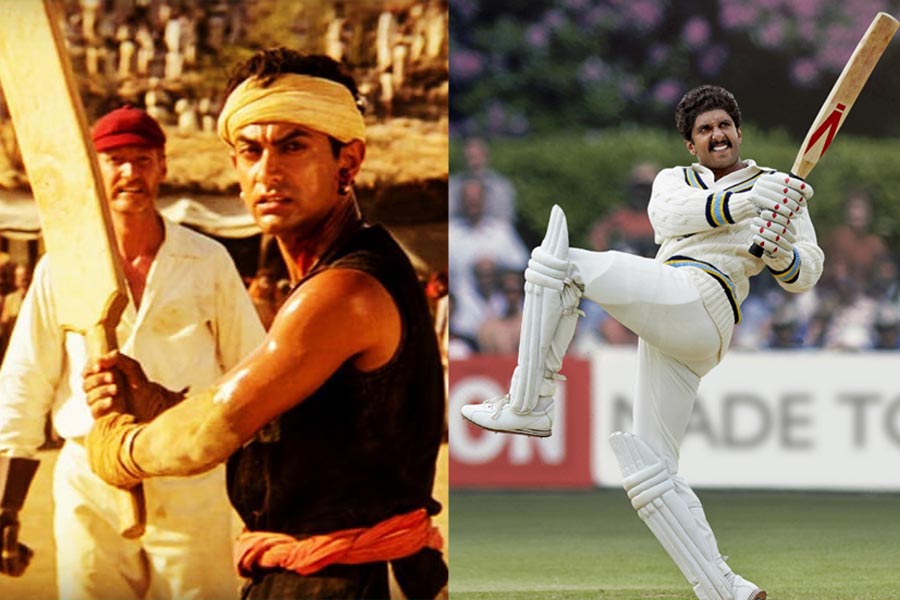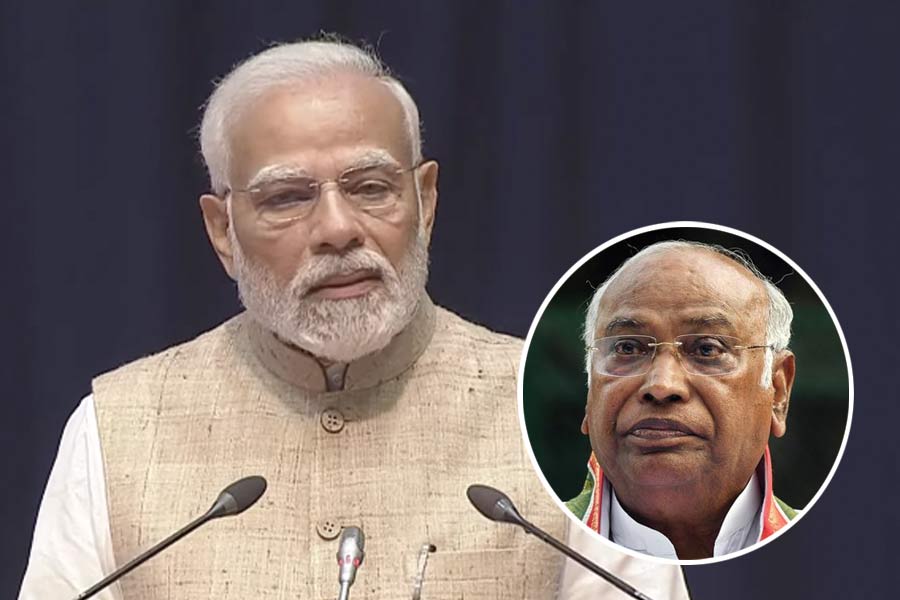‘Iss helicopter ki awaaz ne toh meri concentration hi tod de.’ Leading batsmen all over the world have had lapses of concentration due to a number of factors: crowd movement near the sight screen, streakers invading the field, sledging by the opposition players. But a helicopter whirring over a stadium? That distinction belongs to Aamir Khan. It is 1990. Seven years after India’s miraculous triumph at the Lord’s and five years after the World Championship of Cricket. It is possibly only the third Hindi film at the time that has cricket woven in the narrative. And, needless to say, making a hash of it.
Given the role the game plays in the Indian psyche, it is incredible how Hindi films have seldom got it right. This is even more astonishing when you consider how Bollywood and cricket have always fed off each other in the celebrity stakes. The big three of the 1950s – Raj Kapoor, Dilip Kumar and Dev Anand – were all cricket enthusiasts. Sharmila Tagore and Mansoor Ali Khan Pataudi, Anju Mahendru and Sir Garfield Sobers, Viv Richards and Neena Gupta were the darling of Page 3 even before the term came into use.
Cricketers like Salim Durani, Sandeep Patil and Mohsin Khan have all been bitten by the film bug at one time or the other. Pakistani Test opener Mohsin Khan in fact went on to carve a rather successful career as an actor, with his debut in J.P. Dutta’s Batwara (1989) and then Mahesh Bhatt’s blockbuster directorial Saathi (1991). Other cricketers have made bits-and-pieces appearances in films.
Incredibly, before 1983, there’s only one film I recall which had the hero as an aspiring cricketer, Subodh Mukherjee’s Love Marriage (1959) starring Dev Anand. Its hero, Sunil, arrives in Bombay for a job interview, rents a room and soon gets into arguments with the landlord’s petty daughter, Geeta (Mala Sinha). Geeta watches him play a match and promptly falls in love. The game is however secondary and is soon deep-sixed as love and marriage take over. What stands out in memory is the classic Mohammad Rafi-Lata Mangeshkar duet Dheere dheere chal, and possibly the first Hindi film song with a cricket analogy, ‘He ne khela she se aaj cricket match’, with the classic line ‘Ek nazar mein dil bechara ho gaya LBW’ — no line in Hindi films has conveyed the power of cricket as Cupid better.
In 1983, Hindi filmmakers woke up to the possibility of including cricket in the narrative. There was Kumar Gaurav’s 1984 debacle All Rounder where he plays a cricketer who loses his place in the Indian team after his rival star cricketer gets him drunk! Given that it starred Kumar Gaurav of Love Story fame, no wonder the cricket sucked and the film was more a love story and family drama, with the game just operating in the periphery.
There were other tangential cricketing presence in films like Maalamaal (1988) and Karm Yodha (1992). In the former, based on the novel Brewster’s Millions (reputed as the most remade movie of all time), Naseeruddin Shah plays a small-time cricketer who stands to inherit Rs 330 crore from his eccentric grandfather but on condition that he spends Rs 30 crore in 30 days. Towards that end he gets Sunil Gavaskar to play against his Dharavi XI.
The climax of Dayal Nihalani’s Karm Yodha plays out on the cricket field with Kapil Dev making an appearance to offer protection to the beleaguered protagonist. Rajeev Mehra’s Chamatkar and Sohail Khan’s Pyar Kiya Toh Darna Kya too have cricket making an appearance in the story. And in Hum Aapke Hain Koun, you even have a pup, Tuffy, officiating as an umpire in a family game and declaring a no-ball!
The Good and the Watchable
The good cricket film has largely been an exception. With few filmmakers getting the sport right on screen. Even a documentary like Sachin: A Billion Dreams is so soporific as to induce sleep in the most enthusiastic cricket fan, despite it being an account of the life and times of a cricketer whose heroics could get even the most apathetic viewer to his feet. The few that have been able to buck the trend include:
Lagaan (2001)
The magnum opus of cricket films in India, this is the one that opened the floodgates. Before 2001, there were only three films that had the game as part of the narrative – Love Marriage, All Rounder and Awwal Number. In the 20 years after Lagaan, there have been at least a score more. But few that have captured the nuances and the grandeur of the game on screen as Lagaan did. Today, a couple of decades down the line, I find some of its politics problematic (as filmmaker Neeraj Ghaywan tweeted recently, ‘#Kachra from #Lagaan was one of the most dehumanised voiceless depictions of Dalits in cinema ever’) and its narrative peppered with every cliche in the sports film genre.
But how do you dislike a film that even Roger Ebert calls ‘an enormously entertaining movie, like nothing we’ve ever seen before… [combining] sports with political intrigue, romance with evil scheming, musical numbers with low comedy and high drama… its startling landscapes, architecture and locations, its exuberant colours, its sudden and joyous musical numbers right in the middle of dramatic scenes, and its melodramatic acting (teeth gnash, tears well, lips tremble, bosoms heave, fists clench).’
Iqbal (2005)
This underdog tale is a personal favourite though the themes it addresses are staple sports films ones. Shreyas Talpade (Iqbal) plays a deaf-and-mute boy who aspires to represent India as a fast bowler. He has to contend with his father’s opposition to his dream but finds support from his sister Khadija (Shweta Prasad). Khadija approaches ex-cricketer Mohit (Naseeruddin Shah) to train Iqbal.
Mohit, however, is now an alcoholic battling his own demons. As Iqbal prepares to have a shot at his dream and Mohit seeks to redeem himself, the stage is set for an emotional drama that strikes the right chords. Director Nagesh Kukunoor’s understated approach to the material helps the film overcome the usual tropes of the genre.
Ferrari Ki Sawari (2012)
A charming entertainer from Vinod Chopra Productions, written by Vidhu Vinod Chopra with dialogues by Raju Hirani, this one is a winner right through. Kayo (Ritwik Sahore), who is obsessed with cricket, gets selected for a camp at Lord’s which will allow him an opportunity to play with his idol Sachin Tendulkar. His father Rusi (Sharman Joshi), a clerk, does not have the money to afford this. So he embarks on a plan to steal Tendulkar’s Ferrari, leading to a series of escapades involving Kayo’s grandfather Debu (Boman Irani) who is an ex-cricketer, a wedding planner, a greedy politician and others. Bittersweet, the film manages a perfect mix of drama and comedy that is as much an ode to a boy’s passion for cricket as it is to the relationship between a son, his father and grandfather, and the power of dreams.
83 (2021)
Much panned for reasons that had nothing to do with either its cricket or its cinematic sensibilities, Kabir Khan’s 83 is one of the best films on the game, one that gets right the one facet that all films on cricket have failed at: the way the game is portrayed, its technical nuances. There’s scarcely a false stroke or flawed delivery in the film and the attention to detail has to be lauded.
Add to that the strong emotionally rousing narrative that the director is able to build, and you have a winner. Of course, those who lived 1983 live – over the radio (television was still in its infancy in India at the time) – might have reasons to crib, nostalgia being one. But then, where else would you get to see Kapil Dev’s epoch-changing 175 against Zimbabwe? For recreating that alone, 83 gets my vote.
Shabaash Mithu (2022)
Another film that deserved much better than what it received at the box office. Bollywood has never been at home with biopics, sports or politics, with most films in the genre amounting to little more than hagiography. Avoiding the pitfalls of the genre for the most part, adopting a low-key approach to the inherent drama of the material, and scoring high on the technical aspects of the game, Srijit Mukherji’s film on cricketing legend Mithali Raj is one of the better outings, benefiting immensely from the performance of Tapsee Pannu. While the director gets the cricket right (not surprising because of his love for the game), it is in the little touches that the film scores. The strands of Mithali’s relationship with her coach (Vijay Raaz in a terrific cameo – just watch him literally nail Mithali’s back foot to the ground to teach her the importance of not dragging her foot), and with her childhood friend Noorie (Kasturi Jagnam in the film’s most endearing role) are the highlights.
The early portions between the two young girls are heart-warming, with a delectable opening sequence introducing the two that stumps you with the statement it makes as much as it warms the heart. Even when the film enters into the standard biopic mode, it is these moments that stay with you and that makes Shabaash Mithu one of the better cricket films to have emerged from Bollywood.
The Bad and the Ridiculous
There are many contenders under this. Despite our obsession with the game and the technological advances made in the last couple of decades, films dealing with sports have had a dismal record. In Chain Kulii Ki Main Kulii (2007) – the phrase a take-off from Amitabh Bachchan’s Satte Pe Satta – a 13-year-old orphan brought up on stories of Kapil Dev’s 175 not out in the 1983 World Cup somehow acquires the bat Kapil Dev had used in that innings and becomes a master batter, before managing to lose the bat.
In Victory, which boasts an array of international cricketing stars (Allan Border, Tony Greig, Mohinder Amarnath, Waqar Younis, Michael Hussey, Graeme Smith, Muttiah Muralitharan and Sanath Jayasuriya), Harman Baweja plays an India cricketer who loses his place in the team due to his arrogant ways and undisciplined life. The shock leads to a brain haemorrhage (!) which the star overcomes to make a comeback.
There are other undistinguished ones like Subhash Kapoor’s Say Salaam India (2007), Gaurav Pandey’s Stumped (2005) and Milan Luthria’s Hattrick (2007). In Chandrakant Kulkarni’s Meerabai Not Out (2008), the protagonist is so obsessed with cricket and Anil Kumble (who makes a fleeting appearance in the film) that she arrives late at her own wedding, thus alienating her father-in-law. Eventually, she helps him win a quiz contest (through a phone-a-friend lifeline) by answering a question on Anil Kumble’s ten victims in his legendary 10 for 74 spell against Pakistan.
In Nikhil Advani’s Patiala House (2011) – which features Shaun Tait, Kieron Pollard, Herschelle Gibbs, Nasser Hussain and Andrew Symonds – you have the incongruous Hindi commentary by Sanjay Manjrekar and Nikhil Chopra for an Australia-England ODI at Lord’s!
However, these are the films that make up the crème-de-la-crème of Bollywood’s cricketing hall of shame:
Awwal Number (1990)
Leading the list of the sublimely ridiculous is Awwal Number, where cricket gets the Dev Anand treatment. Here, the evergreen star plays Vicky, an ex-Test cricketer, the chairman of selectors, and also a deputy inspector general of police. If that were not enough, he and his brother Ronny, a star cricketer, have also composed a song on cricket. When Ronny (Aditya Pancholi) finds himself out of favour with the rise of the new kid on the block, Sunny (Aamir Khan), he plans to bomb Wankhede Stadium from a helicopter.
Sunny, who is at the crease at a crucial time in the match, comes up with the memorable line with which I began this piece. Awwal Number belongs to the category of so-bad-that-it-is-good films that Dev Anand specialised in during the latter part of his career as director. If ‘Ronny holding the remote control to a bomb that will destroy the entire stadium, Vicky with a sniper gun, Sunny on strike, and six runs to win off the last ball’ are not enough to make you roll with laughter, you have Dev Anand and Aditya Pancholi giving India its first cricket theme: ‘Maidan hai hara, bheed se bhara, kelne chal diye gyarah, wicket hain gadhe, tayyar hum khade, khel shuru hoga poune gyarah’. Go figure.
Dil Bole Hadippa! (2009)
This disastrous Yash Raj outing casts Rani Mukherji as a dancer in a nautanki who aspires to become a cricketer. Rohan (Shahid Kapoor), who has come from England at the behest of his father to captain an Indian team against Pakistan, has to select the team for India. Veera (Rani) arrives to audition but is refused entry because she is a woman. She then disguises herself as Veer Pratap Singh, and gets selected, leading to a narrative that scores low on almost all fronts — the cricket, the drama, the romance between Veer/Veera and Rohan, the comedy and its gender statement, notwithstanding that Veer/Veera can bat with one hand (after her right arm is fractured) and win the game for India.
World Cupp 2011 (2009)
What do you write about a film that spells cup as ‘cupp’? India’s cricket captain Ravi accepts money from a bookmaker to lose the World Cup final of 2007 against Pakistan. The team gets banned and the players are ostracised. Four years later, as India lose to minnows Zimbabwe and Bangladesh in the lead up to the World Cup, Ravi pleads his case.
Believe it or not, the coach (Suresh Oberoi) and selection committee bring back the entire team for the World Cup! The bookie again makes a play for Ravi to throw the match. Ostensibly dealing with the issue of match-fixing and cricketers’ links with the underworld, this actually makes the flawed Jannat (another film dealing with illegal betting, starring Emraan Hashmi) seem like a classic.
M.S. Dhoni: The Untold Story (2016)
Arguably the most shamefully hagiographic biopic in Hindi cinema, this one is a travesty of a film that airbrushes every unflattering aspect of the cricketer’s life while introducing fictional elements that are plain laughable. Even for an industry notorious for its propensity to go overboard in genuflecting to its subject in a biopic, M.S. Dhoni is a new low.
So missionary is the zeal for sanitisation here that even the cricket comes off as uninvolving. Writing for The New York Times, Rachel Saltz said, ‘You don’t have to understand cricket to enjoy a good cricket movie, for example, Lagaan, but one does have to be a cricket fan, and an indulgent one at that for M.S. Dhoni: The Untold Story.’ She found even the term ‘hagiographic’ unfit for the film and concluded saying, ‘I learned more about Mr. Dhoni… by reading about him after watching this movie than I did during its three long hours.’ Even for a cricket fan like me, this is one story I would have preferred remained untold.
(Shantanu Ray Chaudhuri is a film and music buff, editor, publisher, film critic and writer)










